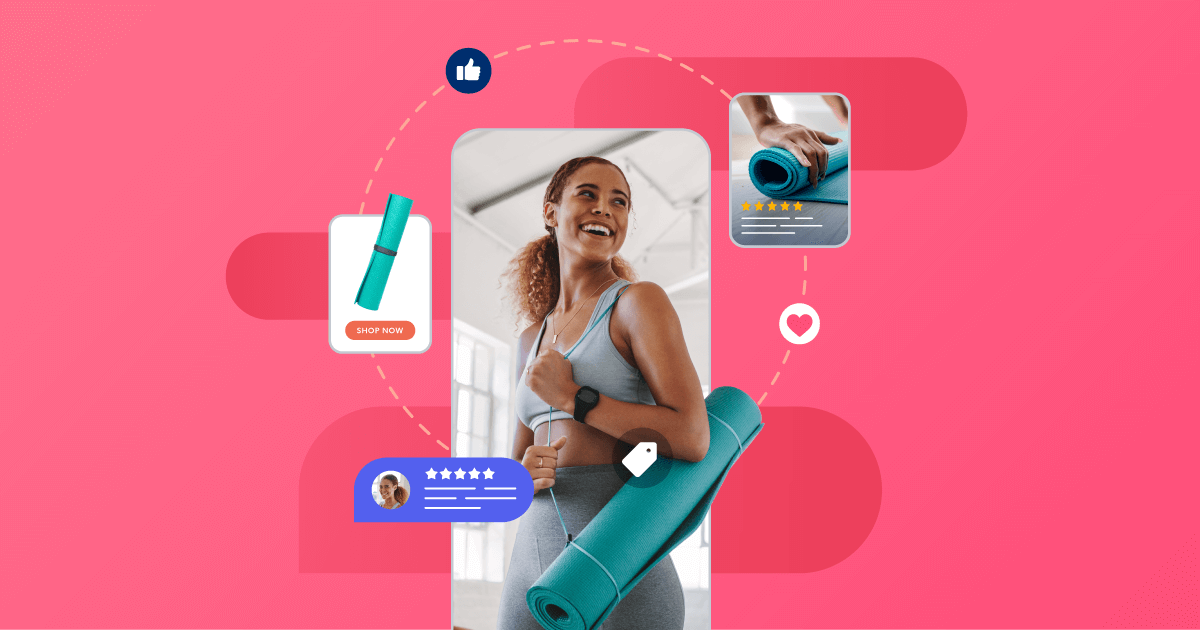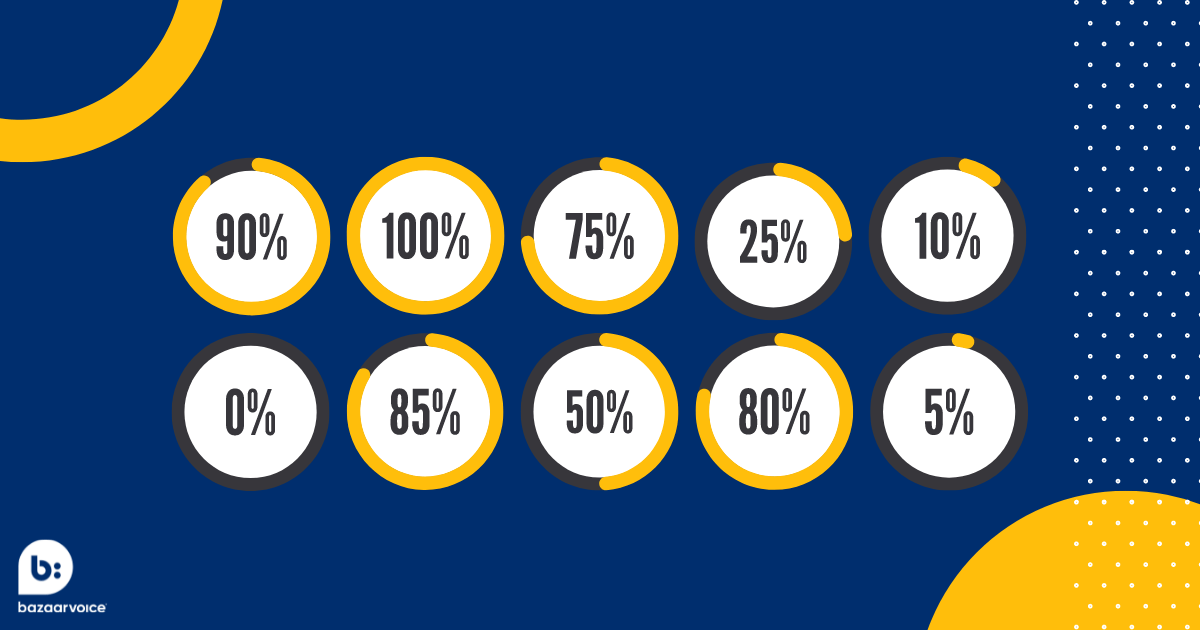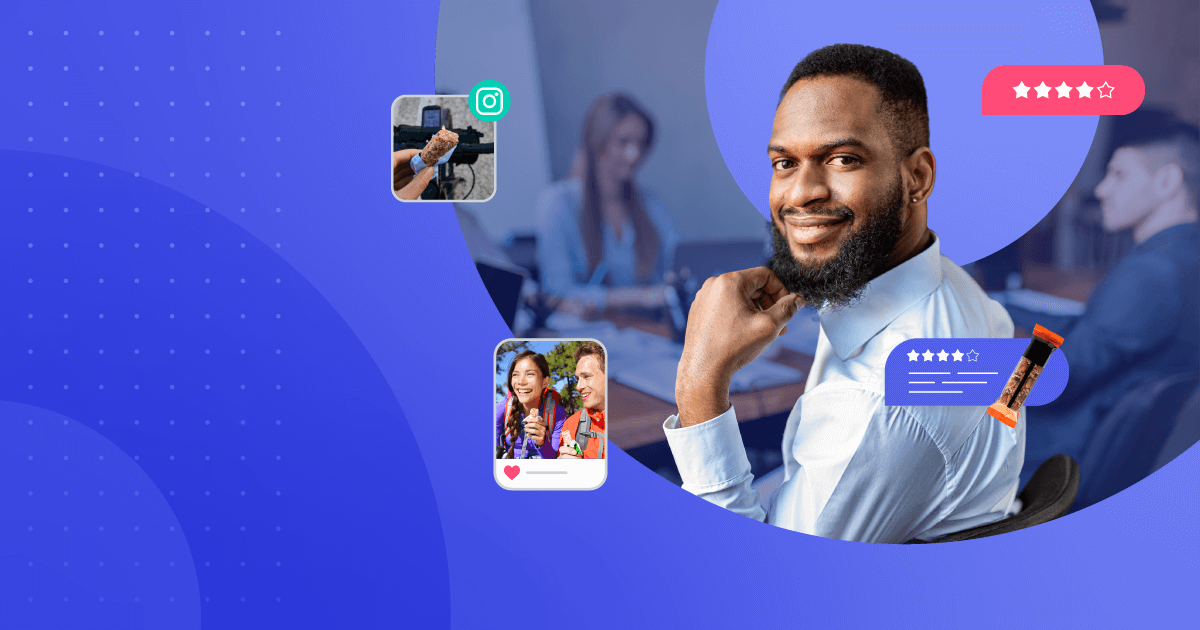March 1, 2024
What powers your online purchasing decisions? Is it a convincing product description or brand loyalty? Or is it recommendations from other shoppers? Most consumers say it’s the latter. According to our Shopper Experience Index, an annual study into changing shopper behavior, 55% of shoppers say they’re unlikely to buy a product without user-generated content (UGC), like reviews, Q&As, and customer photos.
By integrating user-generated content into your marketing strategy you’ll build brand authenticity, drive sales, and seamlessly integrate your brand into the ever-growing creator economy. All absolute necessities to succeed in today’s turbulent market.
Chapters:
- What is UGC (user-generated content)?
- The benefits of user-generated content
- How to increase engagement with user-generated content
- UGC best practices guide
- Curate your brand identity with user-generated content
What is UGC (user-generated content)?
User-generated content, or UGC, is a form of content that’s created by real people to promote your brand. This includes written ratings and reviews, photos, videos, and even audio that your brand’s customers, followers, ambassadors, or even employees create and share across social and other digital platforms.
Recently, user-generated content has evolved to include professional-quality images, engaging videos, and thoughtfully written content that seamlessly support your brand identity. The days of grainy selfies and lacklustre videos are long gone, but UGC has retained its essential component of authenticity.
UGC doesn’t feel like an ad, and just like a word-of-mouth recommendation, it’s often more influential than one.
UGC is far more powerful than traditional brand marketing. Essentially user-generated content is the modern-day equivalent of a product recommendation, and the numbers back it up. 84% of consumers are more likely to trust a brand’s marketing campaign if it features user-generated content, and 77% are more likely to buy a product they found through UGC.
Who provides UGC?
User-generated content is usually found through your customers, brand loyalists, and employees. An easy way to turn customers into UGC creators is to make it easy for them to leave reviews and add their own product photos. Brand loyalists are repeat customers who love your product so much that they’re willing to advocate for you without incentives.
Love them or hate them, the infamous Crocs knows how to rally its brand loyalists, with its hashtag #croctok gaining traction on TikTok and spreading its message to over 300 million viewers.

Finally, employee-created content, like video content discussing the company’s values, acts as a source of UGC that demonstrates diversity, support, and authenticity.
The benefits of user-generated content
Not only is user-generated content more influential than traditional advertising, but it’s also free, authentic, and engaging. There’s several benefits to UGC that have a big payoff for brands.
Builds authenticity and trust
User-generated content showcases how actual people use products in real-world settings. This creates authenticity for brands and allows them to promote products without being overly salesy.
Authenticity means a lot to consumers. 84% of millennials say user-generated content influences their purchasing decisions. And nearly half of Gen Z cites social media as their chief source of inspiration — even above family and friends.
Plus, people trust peer recommendations over branded advertising. A whopping 85% of consumers say they turn to visual UGC, rather than branded content, when making purchasing decisions.
Boosts search engine optimization ratings
Search engines place a premium on fresh and relevant content. UGC often contains keywords and phrases that can enhance the visibility of your brand in search results, indicating that the content is higher quality and more relevant to the reader, which leads to more organic traffic visiting your site.
And as we know, more traffic means more MQLs.
Increases engagement
User-generated content is all about connecting with consumers, building an online community, and creating a conversation between customers and a brand. So it’s no surprise that your content receives 28% higher engagement when UGC is integrated alongside your typical posts.
This is evident in all types of marketing content, including digital ads. When direct-to-consumer bedding and bath brand Parachute incorporated UGC into its retargeting ads, the ads generated a 35% higher click-through rate and a 60% lower cost per click.
What’s behind this higher engagement? It comes down to the fact that people want to get in touch with their favorite brands through social media channels. 60% of millennials alone say brand loyalty influences their purchasing decisions, according to joint research by Future Workplace and Elite Daily.
Plus, the most followed brands on social media are those that share their followers’ content. And engagement breeds further engagement, which inspires the creation of more UGC.
Drives sales
Using data from our Bazaarvoice Network of over 12,500 brands and retailers, we found there’s a 144% lift in conversion rate when shoppers engage with UGC and a 162% lift in revenue per visitor. Further research shows that visual UGC is more likely to convert compared with brand-created content.
78% of shoppers gain more confidence in a purchase when they see UGC, and 35% indicate they’re depending more on UGC during the cost of living crisis, according to our SEI. UGC provides social proof that assures consumers they’re making the right purchase, which translates to more sales.
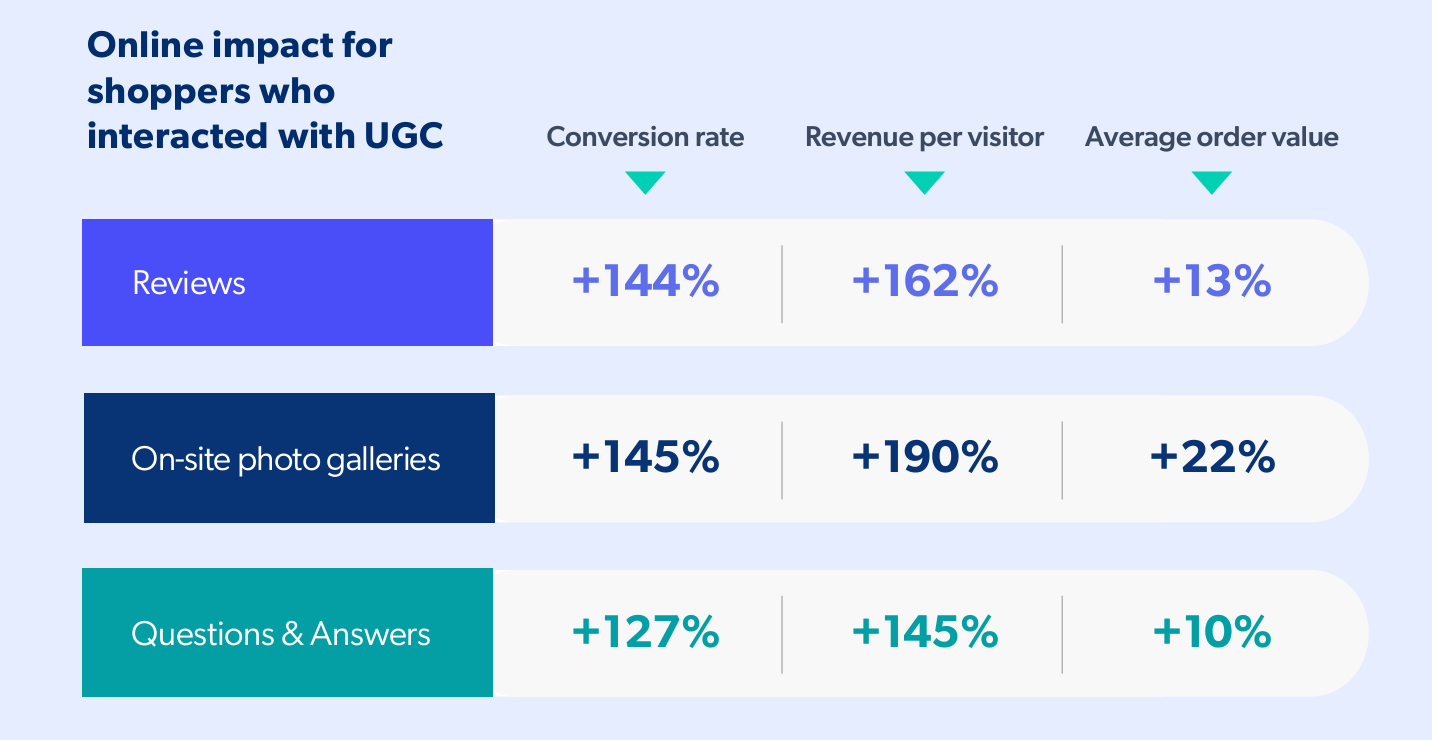
However, some brands have experienced much greater growth in conversions, thanks to UGC. Take apparel brand Tuckernuck, for example. When Tuckernuck implemented a gallery of user-generated content on its website, as well as displayed UGC and influencer photos on its product pages, conversions skyrocketed by 190%.
“Having social content on our PDPs really helps with conversion,” says Kayla Robinson, a Tuckernuck customer experience and marketing associate. “When a customer sees other customers and influencers wearing the product, it inspires her or him to purchase it as well.”
User-generated content can be particularly beneficial to certain industries. The table above compares the click rate of posts both with and without UGC among various industries.
Provides audience insights
Consistently engaging with customers and analyzing the content they post about your brand allows you to better understand your audience. This enables you to not only improve how you interact with customers but also make adjustments to products and services based on customer feedback.
For example, branded hashtags often offer a ton of insight into what consumers want. If you own a cosmetics company, try searching for product names on social media to see what your target audience is saying. Do they want a more diverse shade range or sustainable ingredients? If a lot of people are voicing similar concerns, it’s time to take action and adjust your product offering.
Ratings and reviews also contain a wealth of insights. If you’re constantly seeing customer reviews containing similar feedback, you know how to improve your products going forward. European retailer Vertbaudet noticed multiple customers had left reviews saying a maternity line dress was too small.
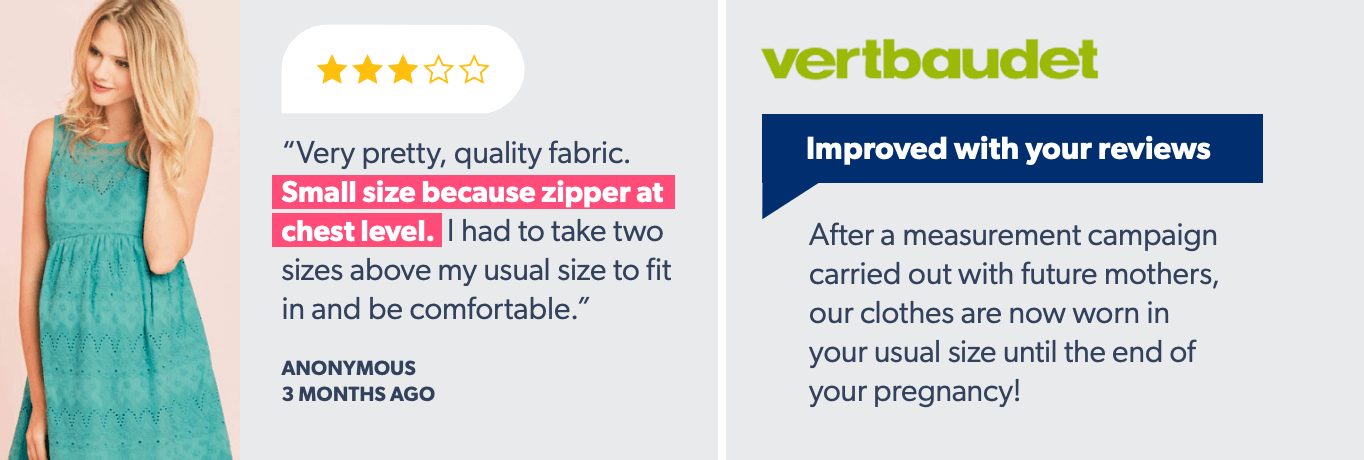
So in response to this feedback, the brand reassessed the dress and fixed the sizing of the cut which led to the average customer rating increase significantly.
Synchronizes with social commerce
Advertising on social media isn’t a novel concept, but social commerce is quickly becoming the new generation of shopping. 69% of shoppers say social media has inspired them to purchase products, and 52% have already shopped through social media. Consumers name convenience and product photos as the top reasons for embracing social commerce.
User-generated content seamlessly aligns with social commerce because UGC takes the place of a branded ad and becomes an authentic, shopper-approved recommendation. Social media users see the UGC on a TikTok or Instagram post, click it, read the reviews, and purchase the product because it’s convenient and doesn’t require them to go to a different website to checkout.
How to increase engagement with user-generated content
Let’s take a look at some of the most inspiring UGC campaigns in the world to emulate for your own UGC strategy.
Host contests or giveaways
Holding contests or giveaways is a classic way to have your customers get directly involved with your marketing campaigns and generate user-generated content
Offering a compelling prize is a crucial element to encourage more consumers to join in with your campaign. However, a good reward isn’t necessarily an expensive gift or a large amount of money. Starbucks, for example, came up with the #WhiteCupContest, encouraging customers to doodle their cups and upload a photo to social media with the #WhiteCupContest hashtag. The best part? The winning white cup drawings were featured as Starbucks’ limited edition reusable plastic cup.
The contest generated great buzz on social media and within three weeks there were over 4000 doodled cups uploaded to Twitter and Instagram.
Incentivize your products/services
By giving customers good incentives to feature your products or services, you can quickly generate a huge number of organic content and tap into their follower communities at the same time.
Hilton Grand Vacations encourages customers to upload their holiday pictures on social media with the hashtag #myHGV for a chance to be featured on their Instagram Feed.
These beautiful images act as a source of authentic inspiration for potential customers to book their next vacation at the hotel.
Develop authentic and inclusive brand messaging
Building an emotional connection between your products and customers is one of the best ways to improve customer engagement and form long-lasting relationships with loyal shoppers.
Women’s clothing brand Aerie launched the #AerieREAL campaign to promote body positivity and inspire women to be comfortable in their skin. The brand encouraged users to post unedited photos of themselves in Aerie’s swimsuits and shared customers’ photos with authentic captions. As part of the company’s initiative to promote real women’s bodies, the campaign was a move to empower women who are fed up with the idealised body type promoted by fashion brands.
Aerie leveraged UGC to create an inclusive community of brand advocates on social media. By spreading the message of body positivity through its customers, there was also a huge boost in terms of brand image.
Partner with influencers
Influencer marketing is a great way to generate buzz and awareness around your products. Collaborating with the right influencers allows brands to tap into an existing audience and drive purchasing decisions.
Before the release of the Samsung Galaxy A model, Samsung collaborated with Blackpink to launch the hashtag challenge #danceAwesome. The dance challenge includes a short dance on the campaign’s catchy music, “Awesome screen. Awesome camera. Long-lasting battery life,” which perfectly highlights the smartphone’s features.
The brand then partnered with influencers like TikTok influencer @hollyh — who has about 16 million followers — to drive awareness of the challenge.
@hollyh working with @samsung on my audition for blackpink 😂 #danceAwesome #galaxyA #ad ♬ Awesome Phone Song(BLACKPINK Ver.) – BLACKPINK
These user-generated content videos went viral across social media and resulted in a whopping 4.7 million user videos with a combined 16 billion views.
UGC best practices
Adding UGC to your marketing strategy is an easy decision, considering the value it delivers, but there’s a few rules you should keep in mind. Follow these best practices to ensure your UGC works for you and your customers.
Develop a UGC strategy
With so many different types of UGC available, and with the countless ways your brand can utilize it, it’s easy to become overwhelmed. However, developing a user-generated content marketing strategy will help you search, curate, and publish the most effective UGC for your specific brand.
Provide clear guidelines
Tell your target audience exactly what kind of content you’re looking for. Only 16% of brands provide clear guidelines about the kind of content they want fans to create and share, but 53% of consumers want specific instructions on what to do.
Let’s say you’re running a giveaway on Facebook for a new product. Make sure the instructions on how to enter are super clear, and the value prop is front and center. Consumers appreciate clear directions as well as general guidance.
Include calls to action on site, on social, in emails, and on receipts, product packaging, and in-store displays. If you’re really in need of UGC, cast a wide net. You can also use a social commerce tool that’s created to source and sort existing user-generated content.
Ask for permission (and give credit)
Just because a customer tags your brand in a post or uses your hashtag doesn’t necessarily mean you can reuse it. So before reposting a user’s creation, reach out to them — whether it’s through email, comment, or direct message — say something complimentary about the content, and request permission to use it.
Once you receive permission, keep a record of it. Take a screenshot of the conversation or save the email in case any issues or questions come up in the future.
Always credit the original source of the content, and tag them if possible. This is respectful of the creator, and it encourages them — and other users — to continue creating content and sharing it with your brand.
Moderate it
User-generated content is considered quality if it’s created by real, non-paid users and conforms to your brand and community guidelines, government regulations, and audience expectations. That’s the only UGC you want. Any low-quality UGC (blurry images, typos, etc) or prohibited UGC (nudity, hate speech, etc) needs to be filtered out, reported, and binned.
Content moderation can make or break your brand. Wanting a high volume of UGC is understandable, but quality is better than quantity. You don’t want to become known for showcasing low-quality UGC because, “Lawsuits and marketing to rebuild a bad public image are expensive” warns Abi Schuman, Senior Director of Content Management Services at Bazaavoice.
Share diverse content
Diversity and inclusivity are essential in marketing. Not only does it help your brand reach more customers, but it also makes your brand more accessible.
Users want representation, plain and simple. To quote Ad Age: “Given the fact that social networks are accessible by people of all backgrounds, shapes, sizes, and families who experience different seasons, communities, and landscapes, the diverse visual content found in UGC feels more like native social media content than advertising.” Couldn’t have said it better ourselves.
Make sure your audience finds this diverse content by syndicating it to everywhere they are.
Track content
Keep an eye on all the UGC around your brand — even the content you don’t use. UGC is like a continuous feedback loop you can use to stay on top of what people are saying about your brand. Bazaarvoice’s Insights and Reports offer a user-friendly dashboard to track and analyze your brand’s different types of UGC content, from reviews to social media posts.
Evaluate content performance
The UGC cycle doesn’t end with distribution, it ends with an evaluation. Consistently compiling product reviews on your product pages that no one sees is a waste of time and money. That’s why evaluating the performance of your UGC campaign and monitoring the data is essential.
Start with our UGC audit webinar here to learn the six core factors that should be evaluated, and get a handy scorecard to see how your content measures up.
Curate your brand identity with user-generated content
Your customers are already talking about your brand on social media.
They’re posting selfies and uploading stories that feature your products. They’re comparing items and making recommendations. So take advantage of this and curate your brand’s content from the multitude of user-generated content out there. And with 69% of people making purchases because they saw a product on social media, it’s also the very kind of content that will inspire your customers to convert.
After all, this is the authentic and relatable content that your followers want, the essential meaning of UGC.
When it comes to answering the question “what is UGC?” few are more qualified than Bazaarvoice. As the #1 user-generated content platform (not our words, the words of G2) we’re well positioned to provide you with a comprehensive UGC education.
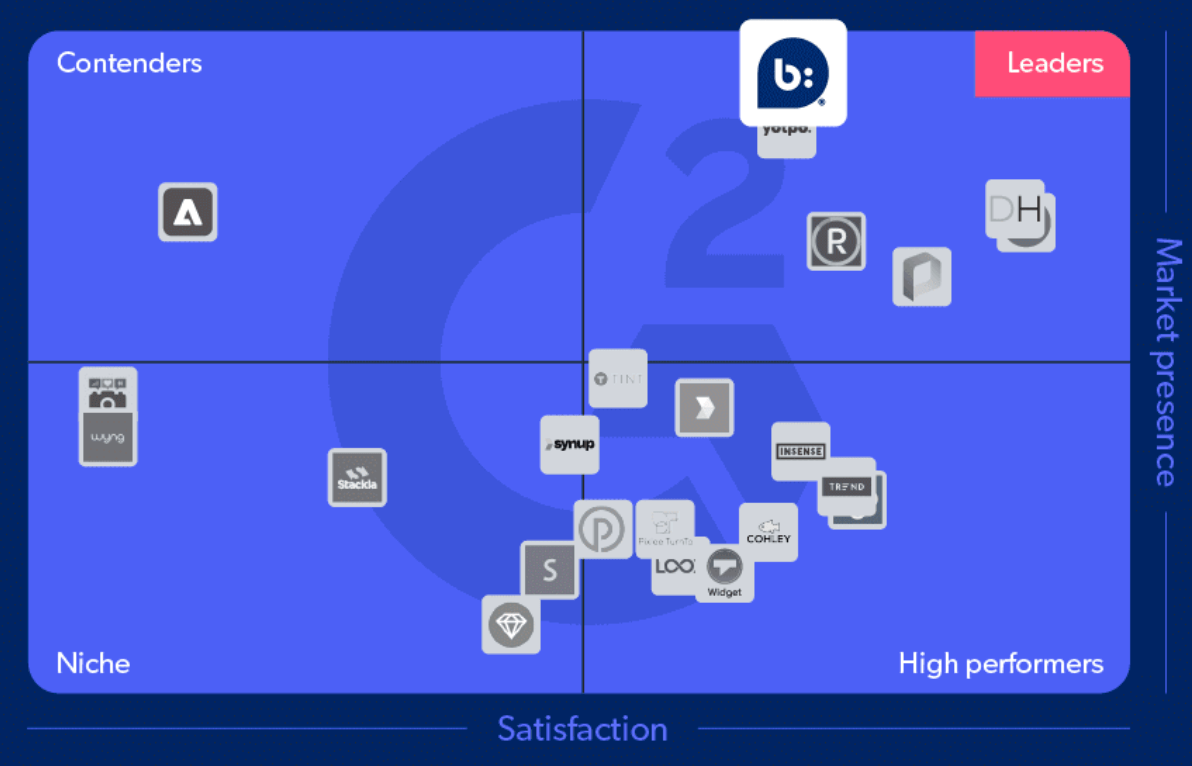
Looking to get started with UGC? Contact us below to learn how Bazaarvoice, the leading UGC platform, can help you transform your brand and marketing strategy with user-generated content and drive a better ROI for your business.
Get started
